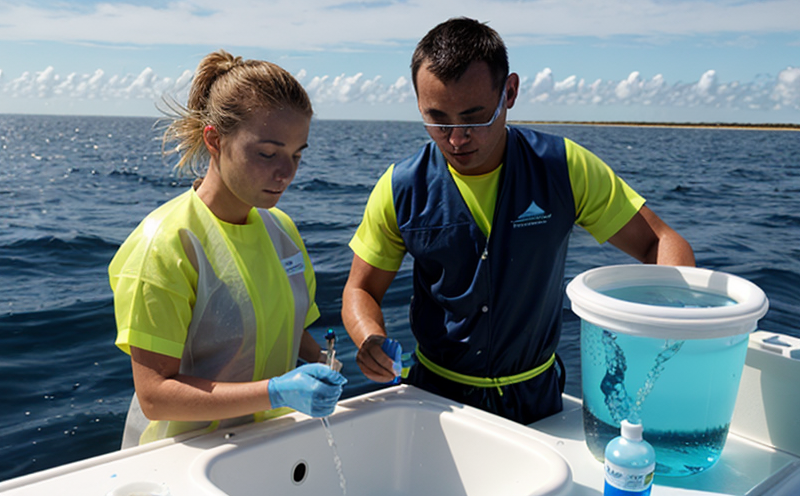ISO 8288 Iron Test in Seawater
The ISO 8288:1985 standard specifies the procedure for determining the iron content in seawater. This test is crucial for understanding and managing the environmental impact of iron contamination, which can affect marine ecosystems and coastal water quality.
Iron contamination often arises from industrial activities such as shipbuilding, offshore drilling, and urban runoff. Accurate measurement ensures compliance with regulatory standards and supports sustainable practices. The presence of iron in seawater can lead to algal blooms, affecting fish populations and the overall health of marine environments. Therefore, periodic testing is essential for monitoring and mitigating these risks.
The test involves sampling seawater, filtering it through a specified filter medium, and then measuring the dissolved iron content using an approved method such as spectrophotometry or colorimetric analysis. The analytical sensitivity allows detection down to concentrations of 0.1 µg/L of iron in seawater.
Compliance with ISO 8288 is important for various stakeholders including environmental agencies, industrial operators, and coastal communities. For instance, shipyards must ensure their operations do not contribute excessively to iron pollution, while municipalities need reliable data to manage stormwater runoff effectively. This test provides a robust foundation for decision-making in these areas.
The ISO 8288 procedure is widely recognized internationally, making it an effective tool for harmonizing standards across different regions and industries. Its implementation promotes consistency in environmental monitoring practices globally.
| Sampling | Filter Medium | Analytical Method | Target Range |
|---|---|---|---|
| Seawater sample collection at specified depths and locations | 0.45 µm pore size filter membrane | Spectrophotometric analysis of Fe(II) and Fe(III) | 0.1–2 mg/L of iron in seawater |
The test is performed by experienced technicians using state-of-the-art laboratory equipment to ensure accuracy and reliability. The results provide actionable insights into the current state of marine water quality, helping stakeholders make informed decisions about their operations and environmental policies.
By adhering to ISO 8288 standards, organizations not only meet regulatory requirements but also contribute positively to environmental conservation efforts. This test plays a vital role in maintaining the health of our oceans and coastal regions.
Scope and Methodology
| Sampling Procedure | Analytical Parameters | Acceptance Criteria |
|---|---|---|
| Gathering seawater samples from specified depths and locations | Determination of iron content using spectrophotometry or colorimetric analysis | Iron concentration within the range of 0.1–2 mg/L in seawater |
The ISO 8288 Iron Test involves several key steps to ensure accurate and reliable results:
- Sampling: Collecting samples from designated points along the coastline or in specific areas of interest.
- Filtration: Filtering seawater through a pre-determined filter medium to remove particulate matter.
- Analysis: Conducting spectrophotometric analysis to measure iron concentrations. This method involves comparing the absorbance of the sample against a calibration curve prepared with known concentrations of iron.
The acceptance criteria for this test are strict, ensuring that only samples within the specified range are considered compliant. Samples outside these limits may indicate potential issues requiring further investigation and corrective actions.
For accurate results, it is crucial to follow the prescribed sampling protocol closely and use calibrated instruments. Regular maintenance of equipment ensures consistent performance over time. Additionally, training personnel involved in sample collection and analysis helps maintain high standards throughout the process.
Why Choose This Test
The ISO 8288 Iron Test is essential for several reasons:
- Environmental Monitoring: Provides critical data on iron levels in seawater, aiding in the assessment of environmental impact.
- Regulatory Compliance: Ensures adherence to international standards and local regulations related to water quality.
- Sustainability: Supports sustainable practices by helping mitigate harmful effects of iron pollution.
- Data Accuracy: Utilizes precise analytical methods that deliver reliable results, enhancing decision-making processes.
- Global Consistency: The internationally recognized standard promotes uniformity in environmental monitoring across different regions and industries.
The test is particularly valuable for stakeholders involved in marine-related activities such as shipping, oil exploration, and coastal development. By incorporating ISO 8288 into their quality management systems, these entities can demonstrate commitment to responsible stewardship of natural resources.
Accurate iron testing helps identify areas where improvements are needed and provides a baseline for future monitoring efforts. This information is vital for developing effective strategies to protect marine ecosystems and promote sustainable development.
Competitive Advantage and Market Impact
The ISO 8288 Iron Test offers significant competitive advantages in the water & wastewater testing sector:
- Reputation for Excellence: Compliance with this international standard enhances an organization's reputation among clients and stakeholders.
- Regulatory Assurance: Meeting regulatory requirements helps businesses avoid legal penalties and maintain compliance.
- Innovation Leadership: By adopting advanced testing methodologies, organizations can stay ahead of industry trends and innovations.
- Cost Efficiency: Early detection of environmental issues reduces the need for costly remediation efforts later on.
The market impact is substantial as well. Organizations that prioritize environmental responsibility are increasingly being recognized by consumers and investors alike. The ISO 8288 Iron Test contributes to this positive image, thereby boosting brand value and market position.
Moreover, adherence to international standards like ISO 8288 fosters collaboration within the industry, encouraging knowledge sharing and best practice implementation. This collaborative environment drives continuous improvement in testing methodologies and environmental protection strategies.





